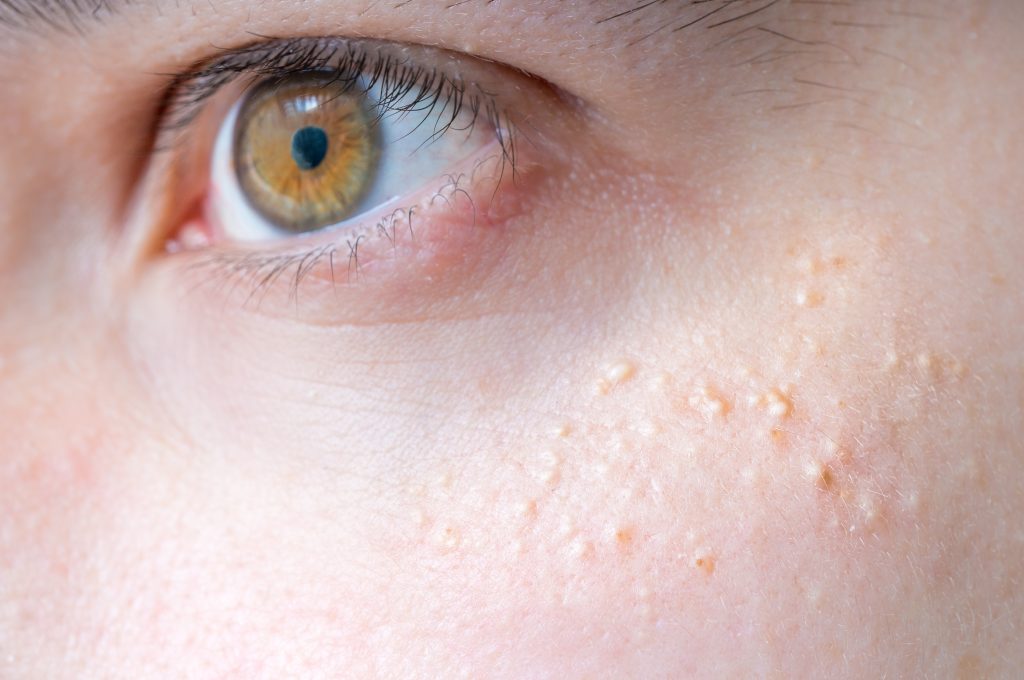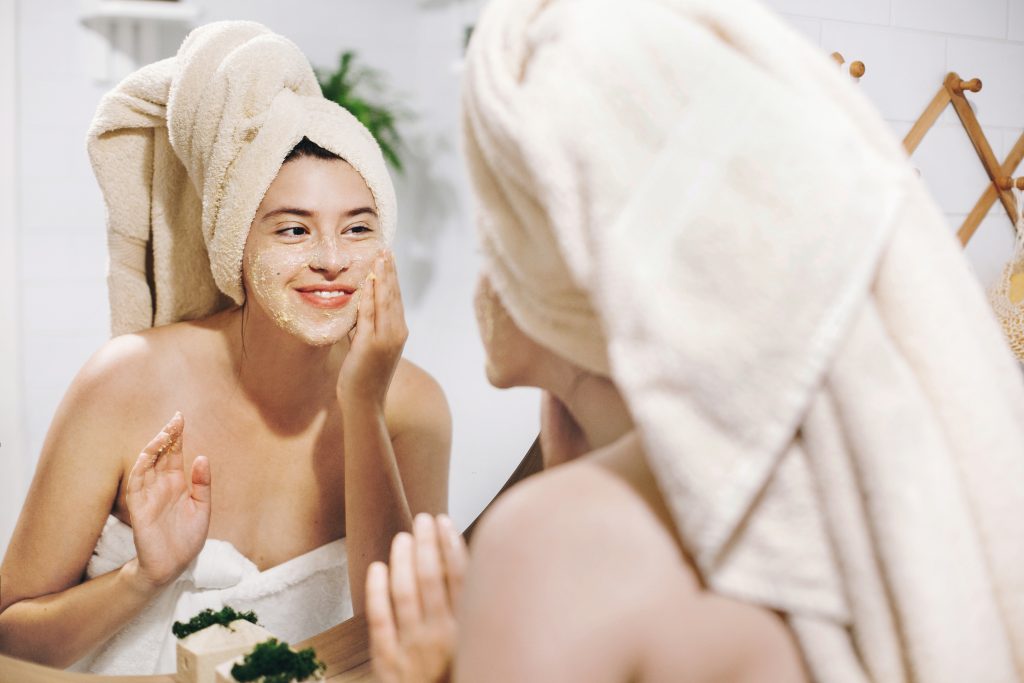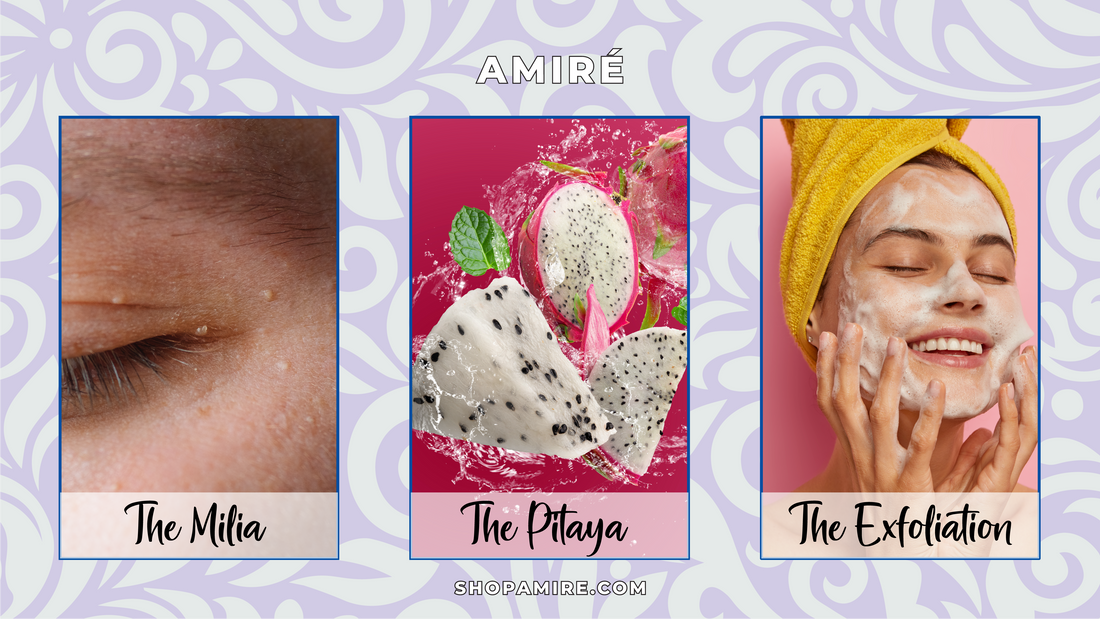As we countdown to the end of this year and the start of a new one, the harsh cold winter really takes a toll on your skin. Dry and unmaintained skin is exacerbated by frigid temperatures and coupled with the wants and needs for rest and relaxation, your beauty regimen might have some slip-ups. It’s perfectly fine to occasionally forget from time to time, though, as one missed day without exfoliation is not the end of the world. Even if some small blemishes start to appear, sometimes they may go away on their own after a few weeks or months, specifically milia.
Milia & Milium Cysts

A common misconception is that milia and acne are very similar, if not the same thing. This, however, is not true as one of the main differences between milia and acne is that acne is formed when a skin pore is blocked. Milia does not form in the pores of your skin, rather it forms just underneath the top layer of skin.
Milia is the plural form of Milium Cysts, which are small, white bumps typically found on your nose and cheeks. Also referred to as milk spots or oil seeds, these blemishes develop when dead skin cells aren’t removed fast enough and are overlapped by new replacing skin cells. This process isn’t painful, nor does it cause any problems besides appearance.
Treatment for milia is very simple. As mentioned before, milium cysts will go away on their own after a few weeks, along with basic cleaning of your skin. It is not recommended to pick or pop milia, as this can cause irritation and scarring of the affected area. The most effective way to treat milia is through exfoliation.
If your milium cysts are becoming more of an issue than normal, we recommend asking your healthcare provider or dermatologist for additional resources or treatments available to you. Treatments for milia are minimally invasive by making tiny incisions into the skin for physical removal using tweezers and a magnifying glass. This should not be attempted by people who aren’t your healthcare provider or dermatologist, as practicing this on yourself or other increases the risk of unnecessary skin damage and infection.
Exfoliation
Exfoliation is the process of removing the oldest dead skin cells from the topmost layers of your skin. Your skin will naturally exfoliate itself and shed the outermost layers of skin, albeit slowly over time. Through artificial exfoliation methods, this can be done chemically or physically, with each method having their own strengths and weaknesses for skin care.
Physical exfoliation is the most accessible form of exfoliation for people, across all knowledge levels of skincare, which involves a coarse medium to manually remove the dead skin cells from your face. These small, rough granules can be made of fine salt crystals, coffee grounds, grains, or jojoba seeds. Care is needed when using this method as ingredients like sugar crystals can cause microtears in your skin or plastic microbeads which are not environmentally friendly, and over-exfoliation can cause scarring and inflammation.

Chemical exfoliation has been the preferred method for most people as it does not involve rubbing of your skin and typically penetrates deeper into the skin while being more gentle than physical exfoliation. Some chemical exfoliants contain fruit enzymes, or alpha hydroxy acids (AHAs) and beta hydroxy acids (BHAs) and are typically the most effective for your skin. AHAs, like lactic or glycolic acid, work better for dry skin types while BHAs, like salicylic acid, work better for acne-prone and oily skin.

Retinol is a Vitamin A derivative that is typically used together with a chemical exfoliant, resulting in smaller pores and fine lines while also helping with your skin’s healing by increasing cell turnover. Using retinol for your skin is a bit of a trial-and-error process, as using too much will result in redness and inflammation. Additionally, using retinol for dry or sensitive skin is not recommended as your skin will likely not tolerate the compounding effects of both treatments.
Pitaya and Dragon Fruit
Hylocereus Undatus is the scientific name for Pitaya, more commonly known in the western hemisphere as Dragon Fruit. It is the budding fruit from several cactus species, which all produce fruits with flesh that almost appears scaly but have a rich and juicy inner center. The dragon fruit extract itself is obtained through juicing and pureeing the whole fruit. Afterwards, it is spray dried in bulk, allowing for a thin layer to evaporate water in large quantities leaving only the dragon fruit essence behind, usually in powdered form as the end result.

Our Dragon Fruit Jelly Scrub has all the fragrance and aroma of dragon fruit, while providing efficient and gentle exfoliation to your body. It is packed with Vitamin C and fruit extracts to help nourish and rejuvenate cells, while the castor oil will seal in moisture and keep your skin hydrated. The jelly texture is softer and gentler compared to other coarse scrubs, making it accessible for all skin types, and the environmentally friendly jojoba seeds will decompose naturally after use while mimicking the appearance of the dragon fruit seeds.
While the effects of chemical exfoliation are minimal, the addition of Dragon Fruit Extract allows some fruit enzymes to work at removing dead skin cells. Normally, fruit enzymes themselves are concentrated and added to dedicated chemical exfoliants, but it is also naturally found in the fruit extract itself. The enzymes will ‘eat’ away and dissolve the topmost layer of skin, allowing for smoother and more vibrant skin, on top of the Vitamin C and antioxidant benefits from the Dragon Fruit Extract.
The exfoliating power of the jelly comes from the jojoba seeds that act similar to the plastic microbeads found in many products years ago by gently polishing and lifting skin cells from your skin. The jelly itself provides all the antioxidant and nutrients your skin needs during and after exfoliation. We recommend using the Dragon Fruit Jelly Scrub as often as any other exfoliant, no more than 1-2 days a week.


